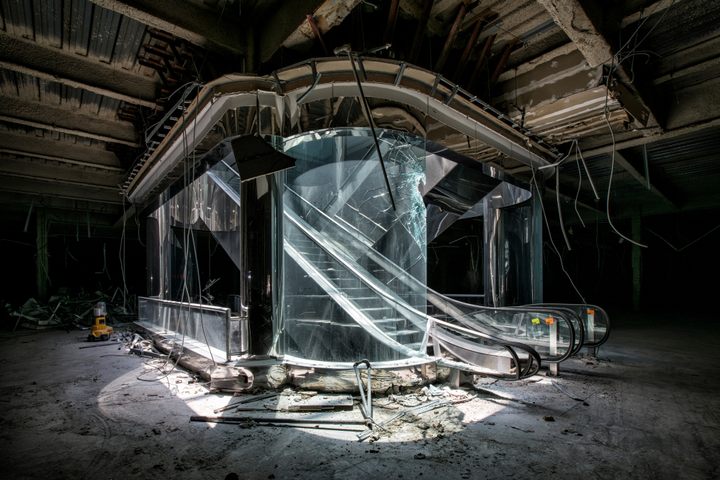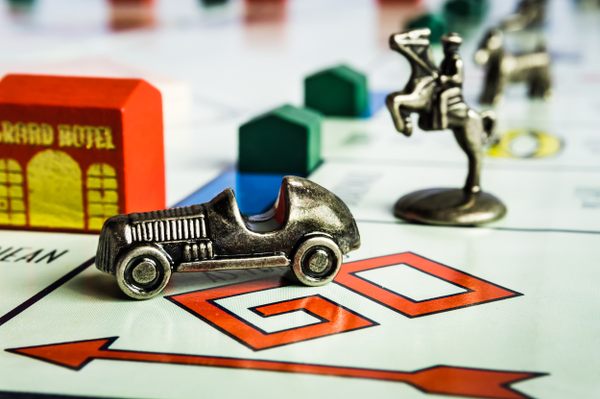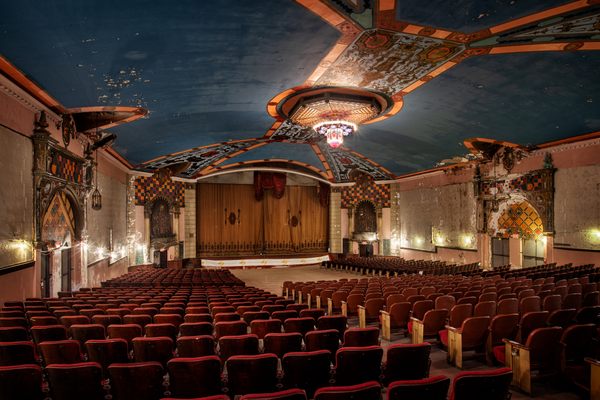
The Life and Death of the American Mall
The indoor suburban shopping center is a special kind of abandoned place.

I’ve visited hundreds of abandoned places in my life—factories to asylums, schools to churches—but suburban malls might be the most surreal and striking. They captivate the imagination in a way few other types of environments can: with an almost imperceptible layer of fog that forms between the first and second floors of an atrium, endless reflections of vacant storefronts, or a chance encounter with a groundhog in the remains of a food court. Stripped of signage and wares, they are nearly perfectly liminal spaces. Malls have become a part of the modern collective unconscious, through both the haze of half-buried memories of any American over the age of 20 and their ubiquity in popular media. They reflect the American consumer’s identity, and to see a suburban mall in ruins warps nostalgia into something nightmarish and forlorn in a way that abandoned factories, hospitals, or even churches don’t quite do.
We are all, to some extent, intimately familiar with the mall experience. Many of us in America had an indoor shopping center that was “our mall” at some point in our lives. Those memories are shared, because even though we weren’t all going to the same mall, we were: franchise stores—Auntie Anne’s, Sbarro, The Gap—share the same layout and inoffensive color palette and logo lettering across the country. To know one of these malls is to know them all. It’s a powerful magic I’m not sure I can fully explain, even after wandering the deserted storefronts of many vacant shopping hubs.
Much has been written on the phenomenon of the collapse of the American mall and the reasons for it. The most obvious—the rise of online retail—is undeniably a significant factor, but it also masks a rot that had been spreading before Amazon gutted brick-and-mortar. It’s hard to think of any comparable social institution that cost so much and covered so much physical space and then imploded so quickly. As always, the story is far more complex than any tidy summary can encompass.

The first contemporary, enclosed suburban shopping mall in America*—Southdale Shopping Center in Edina, Minnesota—was built in 1956, and the idea was incredibly successful. The exodus from urban centers to suburbs created an enormous opportunity to fill a vacuum for goods and services in smaller communities. A mall patron could get their hair styled, buy groceries, visit the bank, and enjoy an art installation all in one building. As the concept gained steam, the mall seemed a well of endless novelty—a preeminent showcase of modern architecture and innovative products. For the archetypal suburban housewife, otherwise isolated, it was a place for socialization and escape. As malls flourished, in many communities they decimated urban shopping districts, which by then had come to be viewed by some as outdated and unsafe.
By their heyday in the late 1970s and 1980s, malls had established themselves as dominant retail hubs, and for developers, they seemed like a never-ending source of income. In communities that already had “their” malls, new ones were built to compete with them: bigger, more upscale, or just different. Even though the popularity of malls would continue well through the 1990s, this competition was the first factor that led to the cascade of closures that followed. There were too many, cannibalizing each other’s customers. Novelty meant that when one mall became dated or, sometimes, viewed as dangerous—often through white shoppers’ perception of nonwhite shoppers and the stores that served them—there was another one to go to instead. A single police incident could turn away scores of patrons for years.

The overabundance of suburban malls heralded a subtle but important perceptual shift—by the 2000s, dated and poorly maintained malls were commonplace, and the view of them as sparkling palaces of wonder and delight was fading. It had become trendy to hate them. Department stores were losing the battle for cost-conscious consumers to big box retailers like Walmart, which spread like wildfire through the 1990s. Poor management, obsolete marketing strategies, and unsustainable expansion left retailers like JCPenney and Macy’s at a tremendous strategic disadvantage against bargain stores like TJ Maxx and fashionable (and often freestanding) chains like Target. Leveraged buyouts, a vampiric process where outside investors purchase controlling shares in companies, saddle them with unmanageable debt, and then liquidate them, wiped out mall staples: Sears, Payless ShoeSource, and Toys “R” Us (though all of those recognizable brands have lingered in some diminished fashion).
The failure of larger anchor stores presented another catastrophic problem. The very size of malls became a liability: dead ends, darkened storefronts, and vacant corridors created eerie, lifeless pockets—and a death spiral. Fewer tenants, fewer shoppers, decreased income, more unkempt areas. Where an outdoor strip mall could simply tear down an underperforming section and build something else, malls were static islands surrounded by seas of asphalt. When online shopping grew, it stabbed a victim that was already bleeding out. The pandemic and inflation didn’t improve the situation, either. In the 1980s, there were roughly 2,500 malls in the United States. Today, there are approximately 700—a number most analysts expect to continue to decline.

Nevertheless, some malls are weathering the storm, at least for the moment: the American Dream Mall in Rutherford, New Jersey, which opened at the beginning of the pandemic, pairs entertainment—indoor water parks, ski slopes, and roller coasters—with unique stores and restaurants, and the Mall of America in Bloomington, Minnesota, narrowly dodged foreclosure through a forbearance agreement. Some malls are turning into mixed-use developments, hotels, and community centers to survive, while others are thriving by catering to certain populations, such as the Asian Garden Mall in Westminster, California. A study by Coresight Research reports that, as of 2022, sales and foot traffic in malls has increased 10 to 12 percent, and malls such as the Select Citywalk in New Dehli, India, are flourishing, as countries with high population density and low online market penetration seek new retail experiences. Downtown shopping districts are also making a comeback in cities such as Alexandria, Virginia, and Oklahoma City, Oklahoma. If anything is certain in the quickly changing retail environment, it’s that nothing is: There are no sure bets, and the champions of today’s marketplace may be buried in dust and shadows tomorrow.

As an explorer of abandoned places, though, I go to dead malls, with their problematic history of devastating downtown districts, in an attempt to reconcile their spotty legacy with the fond memories I have of them: reading comics in Waldenbooks, gazing longingly at K·B Toys, playing Street Fighter 2 in the arcade in the basement, and petting puppies and kittens in the pet store. My mother worked at a John Wannamaker store with a giant eagle statue perched by the railing in front of the second-floor entrance, gazing down at the shoppers below. I vaguely recall winning a Halloween costume contest at our mall when I was six or so—I was a pirate, by the way. These empty malls I see, by virtue of their similarity, are my mall, too, and they are stuffed with the same kinds of memories: ear piercings at a cart, first jobs at the Orange Julius, love connections at the Sam Goody’s. Compared to a thriving galleria at its zenith, big box stores and online retailers seem shabby and isolating. There’s nowhere to sit, no fountains or planters, no people-watching. Perhaps as a culture, we have outgrown the mall, but it is an emotional loss. We may not have always wanted to go them, but we miss them when they’re gone.
I don’t believe that ghosts haunt us, but memories most certainly do. A dead mall is filled with echoes and the sting of lost youth. Even if we find nothing to mourn there, the Age of Malls as we once knew it is over and will most likely never be repeated. My hope is that the photos I take of them in their final days are both a shared reminiscence and a final goodbye.
* While one could argue that enclosed arcades such as the Philadelphia Bourse or Cleveland Arcade predate Southdale and thus may be considered earlier malls, arcades were an urban phenomenon rather than a suburban one. They were direct competitors with the department stores that anchored malls. Though the history of arcades and their differences from modern malls is beyond the scope of this article, I recommend this article for further reading on them.
Matthew Christopher is a writer and photographer who has explored abandoned locations across the globe for two decades, chronicling the lost landmarks in our midst. You can find more of his work on his website Abandoned America or listen to his Abandoned America podcast.























Follow us on Twitter to get the latest on the world's hidden wonders.
Like us on Facebook to get the latest on the world's hidden wonders.
Follow us on Twitter Like us on Facebook